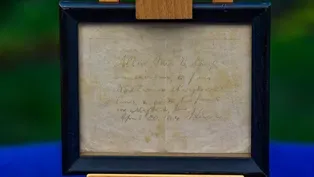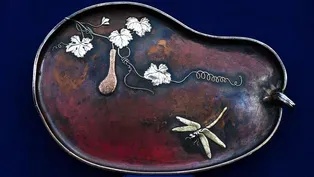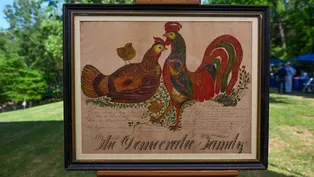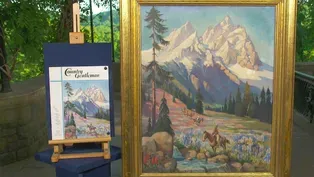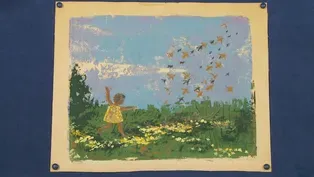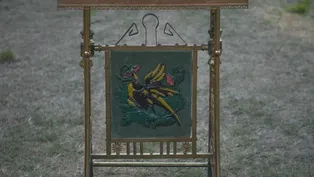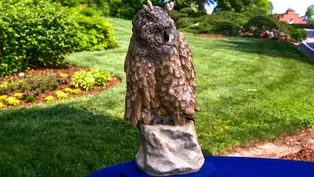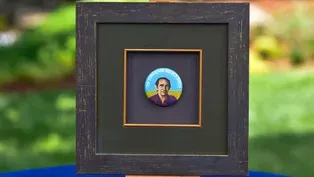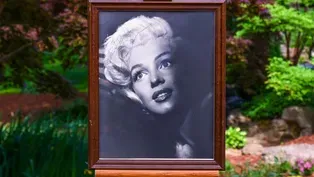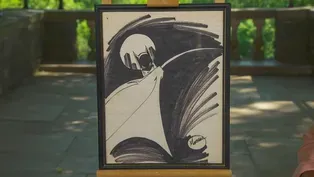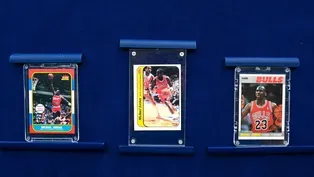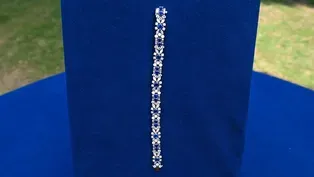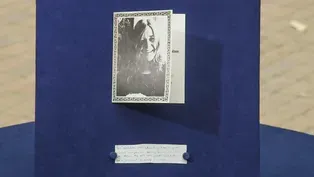
Cheekwood Estate & Gardens, Hour 3
Season 27 Episode 9 | 52m 27sVideo has Closed Captions
New noteworthy Nashville appraisals at Cheekwood Estate & Garden. One is up to $50,000!
New Nashville appraisals at Cheekwood Estate & Garden, including a Marilyn Monroe signed autograph, 1986 - 1987 Michael Jordan basketball cards & sticker, and a Tiffany & Co. diamond & sapphire bracelet, ca. 1960. One is up to $50,000!
Funding for ANTIQUES ROADSHOW is provided by Ancestry and American Cruise Lines. Additional funding is provided by public television viewers.

Cheekwood Estate & Gardens, Hour 3
Season 27 Episode 9 | 52m 27sVideo has Closed Captions
New Nashville appraisals at Cheekwood Estate & Garden, including a Marilyn Monroe signed autograph, 1986 - 1987 Michael Jordan basketball cards & sticker, and a Tiffany & Co. diamond & sapphire bracelet, ca. 1960. One is up to $50,000!
How to Watch Antiques Roadshow
Antiques Roadshow is available to stream on pbs.org and the free PBS App, available on iPhone, Apple TV, Android TV, Android smartphones, Amazon Fire TV, Amazon Fire Tablet, Roku, Samsung Smart TV, and Vizio.
Buy Now
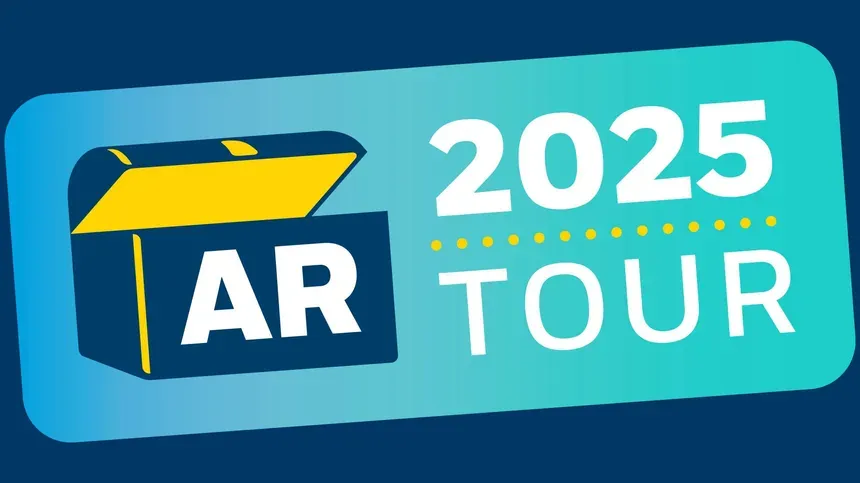
ANTIQUES ROADSHOW 2025 Tour!
Enter now for a chance to win free tickets to ANTIQUES ROADSHOW's 2025 Tour! Plus, see which cities we're headed to!Providing Support for PBS.org
Learn Moreabout PBS online sponsorship♪ ♪ CORAL PEÑA: "Roadshow" is singing the praises of treasures we found in Nashville at Cheekwood Estate and Gardens.
(laughing): I'm floored.
I'm really floored.
Comics in general are just wicked-hot.
Wow.
That's wonderful.
Awesome.
(both laugh) ♪ ♪ PEÑA: Cheekwood is a remarkable American country house, with inspiring views that stretch from the estate to downtown Nashville.
Inspiration comes in many forms, and the origin of the Cheekwood mansion starts with this mirror.
In the 1920s, Mabel Cheek fell in love with this floor-to-ceiling gilt mirror at an antique shop in Atlanta.
But it was too tall for the home she and her husband, Leslie, had at the time.
Leslie is said to have remarked that the couple would either need to sell the mirror or build a bigger house.
And, well, here we are.
Let's see what treasures our guests were inspired to bring to Cheekwood.
WOMAN: It's a painted button by an artist named Carroll Cloar.
It came from my mother, she gave it to me, and she had acquired it from a neighbor, who acquired it from a friend of the artist.
APPRAISER: So your mom, was she a collector?
She likes everything.
And she's a great eye, so she just has a number of things.
And this is one of the things I thought was fabulous.
And so when she offered it, I said yes.
Well, let's take a look at the back of the frame, because there's a pretty lengthy inscription there.
And tell me about what you know about who might have written that.
So that was definitely written by my mother.
She has very distinct handwriting.
I had asked her to write everything she knew about it so that I wouldn't forget.
Yeah.
And it says "Portrait of and by "Carroll Cloar, circa 1970s or 1960s, "owned by his friend and fellow artist Bill Womack.
"Memphis Art Academy artist show button given by Mr. Womack posthumously."
Her neighbor was a friend of Mr. Womack, so that's my understanding of the path.
Gotcha, okay.
And so she didn't purchase it.
It was given to her.
I just love to have those personal anecdotal stories about a work of art.
To me, it enhances its value sentimentally and, you know, financially.
Absolutely.
Because the more we know about, uh, a work like this, the more interested collectors are in our industry.
Oh.
Carroll Cloar, he's a Southern artist.
He was born in 1913 in Earle, Arkansas.
He went to the Art Students League in New York.
But he really became well-known painting Southern subjects.
So almost surrealist Southern subjects, landscapes, and lots of subjects invoke memories of his childhood, of the South.
Ah.
Um, and so what's written on that button, can you read that for me?
It says "My father was big as a button."
Probably his most highly regarded work is in Memphis today.
Oh.
And the title of the painting was called "My Father Was Big as a Tree."
Oh, okay.
And it was sort of an emotional subject.
He's seated in a, a toy car, and his father's this imposing figure in the foreground of the painting... Oh.
...in front of a tree.
So that series really propelled Cloar to the fame that he achieved in the 1950s.
This is a self-portrait of the artist.
It's hard to pin down exactly when it would have been executed, but in all likelihood, after 1955 sometime, when he produced "My Father Was Big As A Tree."
So this would have been painted in the '60s or the '70s.
The medium is oil.
It's an oil painted over a button.
And it's done in his style of, almost imitative of the Pointillist painters.
Generally, what you see from Cloar are anywhere from 20 by 30 inches to 30-by-50-inch oil-on-canvas paintings.
This is a bit unusual in that it's in the form of a button.
So do you have any perspective on how that might have came to be?
So my understanding is that the button was created by him w, for him to wear during his show.
He is a highly desirable painter, especially in this region.
He is growing in demand, especially in the last decade or so.
So while this is a bit unusual-- it's atypical for his, for his work... Mm-hmm.
...it still has a lot of bells and whistles that a collector might want.
Mm-hmm.
At auction, I would suggest that the value of this would fall in the $5,000 to $7,000 range.
Oh, my gosh!
That's amazing!
(laughing) (laughing): I'm, I'm not going to tell anybody else in my family.
(both laughing) That's fabulous!
That is, until they see the show.
Well... (both laughing) Shh.
His paintings recently... Mm-hmm.
...have started to sell in the region of $60,000 to $80,000.
Oh, my gosh!
Yeah.
(talking in background) Hi there.
Hi.
WOMAN: So what is this?
WOMAN: A sugar chest.
When we bought it, somebody said that it was from 1830.
We paid about $2,800 for it?
Yeah.
She was my grandmother's.
Um, she was born in 1932, so I'm suspecting she's really old.
She told me it was hers from when she was a little girl.
The ones I've seen on the "Roadshow," they can be creepy, but I, I, I don't think I'm creeped out by this when I played with her when I was little, so... She's important to me.
MAN: Does it come alive at night?
No.
(laughs) WOMAN: I inherited this through my family.
I had an uncle, Jack Petrie, who was a gifted musician, and he played for Fred Karger off and on, who was in charge of the music for Columbia Studios.
Fred Karger was her vocal coach.
And somewhere in there, Jack met Marilyn.
He accompanied her on the piano a few times.
He met my Aunt Paula, who was a housemate of Marilyn's.
And Fred Karger's mother had a house that she allowed young starlets to live in.
And I don't know if it was the house she lived in or if she had a house that she rented out.
Musicians play anywhere they can make a little money.
And so Jack played for Ronald Reagan's first wedding.
And he was up in the choir loft.
And Marilyn had a crush on Ronald Reagan, so she was up there with him.
They were crawling around on the floor looking for a plug to plug the organ in.
(laughing): Or something like that.
That's really the main story I remember him telling about being with Marilyn.
Crawling around in the rafters looking for a plug.
(laughing): Crawling around in the rafters looking for a plug.
How did this picture come about?
He had to go pick her up at the airport in Los Angeles, and my grandparents were there on vacation, and that's why it says "To Mom and Pop Pete."
But I'm in doubt about the signature.
I don't know whether the signature was Marilyn's or if it was a secretary that mailed it to them.
They didn't get it that day, they, they got it later.
Did they have any impressions of her?
They just, they just said they met her, and I'm not sure what, what they knew to say to Marilyn in the car.
(laughing) They must have left an impression, 'cause she made sure that they got a photograph.
It was very sweet of her to make sure they got the photograph, yes.
So the first thing that we do, obviously, when we look at photographs is, the most important thing is whether this was signed by Marilyn or by one of her secretaries.
Sure.
Because they obviously had a lot of pictures that were sent out signed by other people.
Yes.
There've been some things put out there that, there's a distinction in whether it's secretarial or not based on ink color.
Ah.
That red ink meant it was signed by Marilyn.
Yes.
And, or green ink.
And if it was not, then it was a secretarial.
And it's actually the exact opposite.
This is 100% Marilyn's signature.
(laughing): I'm floored.
I'm really floored at that.
But that's fantastic.
Yeah.
I love it, I've always loved it.
But she has a very distinct handwriting.
Yes.
And more often than not, the pictures that are really signed by her are actually just in ballpoint pen.
Oh, my goodness.
And if ever she actually does veer towards a color, it's usually green ink.
And so most of the red ones out there are actually secretarial.
I've watched other programs, and, and I've heard that she signed 'em in red ink, so that was, that was where the doubt came from, so...
I'm glad we're clearing this up today.
(laughs) This was taken by a man named Frank Powolny.
Okay.
Who was the lead photographer for 20th Century Fox for about 40 years.
Most famously, he shot the picture of Marilyn from Niagara that was used by Andy Warhol to make the famous print of her face.
That was one of his famous shots of her.
Yes.
But he shot her for a lot of films.
This was shot for publicity for "Gentlemen Prefer Blondes."
And "Gentlemen Prefer Blondes" was filmed late 1952 into early 1953.
So this would have been printed most likely in 1953, which is probably when it would have been sent, circa that time.
By '55, she kind of was spending a lot more time on the East Coast.
Mm-hmm.
And so I, I think that's probably when this would have happened.
Okay.
On top of it, it's a fantastic photo.
(laughs) And so when we look at value, I like to always go down these checklists of, like...
Yes.
...what do you want to see when you have a good photo?
Yes.
You want a glamorous shot.
And it couldn't be more glamorous than this.
No.
You want a good size, which we have.
Yes.
This isn't an eight-by-ten, this is 11 by 14, which is fantastic.
And the other thing that is really important, apart from the fact that we know it's authentic, we also know the story of who this is to now, because a lot of the photos that get out there, they're signed to someone, and we have no idea who they were or what connection they had to Marilyn.
Yes.
But you've provided that for us today.
But the last thing that's really important that I, I think people instinctively know, but don't often state openly, is, how visible is the signature?
Because she signed this across her hair, it's a huge plus for value.
I think conservative, you would expect to get anywhere between $20,000 to $30,000 at auction.
I'm floored.
(laughs) I lived with this photo from the time I was a child, had no idea, and it's just been hanging around.
(laughing) So that's amazing, that's amazing.
In the past two years, a few have sold for as much as $50,000 and $63,000 that were, I would say, comparable in quality to yours.
So if it did do well in excess of that estimate, I, I wouldn't be surprised, because there are only so many of these out there that are authentic, and... My goodness.
Again, having your story is pretty fantastic.
(laughing): My goodness, yes.
If I were to insure it, I would probably put no less than $50,000 on it.
That's great, we'll do it.
PEÑA: Cheekwood was completed in 1932 after several years of construction, even in the midst of the stock market crash and Great Depression.
Leslie Cheek, Sr., enjoyed his country escape from downtown Nashville for only a few years, as he died suddenly in 1935 at the age of 61.
After her mother's death in 1946, Huldah Cheek Sharp inherited the estate, later offering it as a site for a garden and art center in 1957.
Cheekwood opened to the public in 1960.
WOMAN: That is my Tiffany tray.
I bought it many years ago.
I l, admire Tiffany things, and so anytime I would see something Tiffany that I could afford, I would buy it.
So I've had this tray since the mid-'70s.
I bought it at an antique show that traveled to Atlanta every year.
Mm-hmm.
I think I paid $95.
My husband thought I paid too much for it.
Okay.
And I didn't bargain.
It's a really unusual piece of Tiffany.
You know, Tiffany made a lot of things.
They did a lot of metalware, but they did other, other mediums...
Right.
...mediums, as well.
But this piece is very interesting because it is mixed metal.
Mm-hmm.
It's primarily copper, but it has the addition of several other metals, including gold and silver.
It dates from the year 1878.
This particular type of design is called Japanesque, and the Japanesque design occurred about the 1870s or so.
It coincided with the opening up of trade to Japan... Mm-hmm.
...in the mid-19th century because of a treaty with Commodore Perry.
As Japanese manufactured goods became, began coming into United States and other countries, everyone was very interested in things that had the Japanese appearance.
Yeah.
So American and English and European companies began making things that looked like objects made in Japan.
Mm-hmm.
And so this is Tiffany, an American company, imitating things that would have been imported from Japan at the time.
The interesting thing is, is that people are more interested in the objects that are the copies by Tiffany and their other American and European makers than they are about the, the objects that were actually made in Japan and exported.
Right.
It's very Japanesque in sh, in style and shape and so forth.
You've got a wonderful gourd shape.
Which is a highly unusual shape.
Mm-hmm.
You've got the ha, the, the, uh, stem of the gourd, which is curling back, and that's made of silver.
Mm-hmm.
The base of the tray is made of copper.
You've got this great dragonfly, and the wings are gold.
They're probably 18-karat gold.
And then you have, uh, the, the, the leaves of this plant here made of sterling silver, and the vines of sterling silver that are nicely curling.
A little blossom here, also made of gold.
But the thing that makes this super-special is this wonderful gourd that is in this mixed metal called mokume.
Oh, okay.
So it's a technique whereby they take layers of different kinds of metal, in this case, copper and silver, and they roll them over and over and over until you get this very intricate sort of mottled effect.
We rarely see pieces with this mokume added to it.
Oh, okay.
And that steps it up a whole 'nother level than if it did not have that.
Okay.
(chuckles) It does have some condition issues, though.
Right.
I mean, you see how the, the copper, the copper background is not uniform in color?
What would be appropriate for it is if it were all this sort of nice red color.
Exactly.
So I'm going to flip it around so you can see the color of what it would have originally been, this nice sort of red color.
Yes.
And then this is the Tiffany mark, and the numbers here correspond to the date, year of 1878.
Oh, okay.
Well, this is really a hot area of collecting... Mmm.
...mixed metals, and particularly Tiffany silver.
And objects from this time period, which we call the Aesthetic Period... Mm-hmm.
...are very, very popular with collectors today.
As a mixed-metal tray, silver on copper, if it didn't have the gold, you probably would be talking a few thousand dollars.
$3,000, $4,000, $5,000.
Mm-hmm.
The addition of the gold pumps it up to maybe $8,000 to $10,000.
Oh, okay.
But when you add this mokume to it, that doubles that, and you're looking at more like $20,000 to $25,000 at auction.
Well, very interesting.
(both laughing) Okay.
I'm pretty excited about that, with my $90.
MAN: I attended the University of Alabama.
APPRAISER: Mm-hmm.
I was there between '77 and '81.
We won two national championships, '78 and '79.
I was the student aide to Coach Paul William "Bear" Bryant.
He was so generous.
He gave them to the secretaries, to the men who watered the practice field, and to the little skinny-- back then-- student aides.
(chuckles) So we've got "1979" here, we've got the diamond.
And it says "Alabama, Sugar Bowl, 24-9, S.E., S.E.C."
We beat Ohio State.
College championship rings are basically valued on who they were given to and what the championship was, right?
Certainly, certainly.
So great team, 19-0, one of Bear Bryant's best, wouldn't you say?
Oh, no doubt.
An auction estimate's going to be somewhere between $2,000 and $4,000, okay?
Yes, ma'am.
I wanted all those University of Tennessee people to know that Alabama's in town, baby.
(laughing) And we don't take prisoners.
Yeah, I wore it especially for that reason.
Isn't that hateful?
Pray-- as we say in the South, pray for me, please.
(laughs) Because my intentions were nothing but bad.
(both laugh) Don't insure it any less than $10,000, okay?
Okay.
Rammer Jammer, Roll Tide.
WOMAN: I actually got it at a estate sale maybe six months back.
Paid about $20 for it.
What you have here is an original sketch or drawing by William Marshall Rogers III, just more professionally known as Marshall Rogers.
Contrary to most comic book artists that have that mile-long resume of all the books that they've worked on, Marshall Rogers actually doesn't have that big of a resume.
But what he worked on was really important when it comes to the Bronze Age of comics.
Marshall Rogers was primarily a penciller for both DC and Marvel Comics.
And a penciller is the person in the beginning of creating a comic book, they're the first person as part of the creative process.
They're drawing the figuration, the rough preliminary sketches, that then the inker and the colorist go in to perform, to create that full finished comic book.
One of his earliest works was "The Deadly Hands of Kung Fu," working for Marvel, which was a black-and-white magazine.
But what he was really known for was his work on a very important, crucial part for DC Comic and Batman fans.
So 1977, 1978, Detective Comics issues 471 to 476.
Now, this is only six books within the long history of Detective Comics, going back to the 1930s.
Now, this six-issue run, we have Marshall Rogers as the penciller, we have Terry Austin as the inker, and Steve Englehart as the writer.
Now, these three combined were the perfect trifecta to come up with what fans consider some of the most iconic Batman storytelling to come out of the Bronze Age.
It really pinned the Joker as this dark, sinister character that we have now seen over the past 20-plus years of film.
It went on to influence the 1989 Michael Keaton movie, uh, with the interpretation of the Joker within those pages.
It also went on to influence the "Batman" animated series that came out of the '90s.
Now, when we look at this drawing, it is not something that was published.
It's not something that would have appeared in a comic book.
It's just simply a sketch.
But looking at this, it has all that primo aesthetic that we want out of Bronze Age Batman.
And what I mean by the aesthetic is just the way the cowl swoops down, the aggression on the face.
We have the Gotham City skyline highlighted behind his head.
It just is iconic and totally resembles what we see in issues 471 to 476.
When looking at the drawing, we can tell that as a medium, he used pencil, ink, and marker.
It is not dated, but based on the style and the aesthetic of the Batman, I know that it was definitely done, I would say, approximately a decade after that initial, you know, 1977-78 run on Detective Comics, 'cause the look of the Batman here is very indicative to a lot of the cover art that he was making at the time.
Marshall Rogers unfortunately passed away in 2007.
He was young, you know, he was only in his 50s at the time.
Comics in general are just wicked-hot.
It's one of the hottest fields of collecting.
And comic art, when you think about it, the comic book is like the print, right?
There's multiples of it?
But an original piece of artwork is something that collectors really prize today.
It's a great size, approximately 14 by 11.
And it just has that iconic look.
At auction, I'd conservatively estimate it at $800 to $1,200.
Wow-- for $20?
(chuckling) Yeah, for your $20 investment.
Wow, that's pretty awesome.
(both laughing) I'm, like, what?!
♪ ♪ WOMAN: Well, this belonged to my mother's oldest brother, John.
He was born in the late 1800s.
He was in World War I, but we don't know exactly where he got it.
We think he learned about beautiful art when he was in Europe, and then he wanted to build a beautiful house when he came back.
And he was going to have a niche, and this owl would be the feature.
But then he had some financial setbacks and he never built the house.
And he eventually gave this to his youngest sister, my mother.
It's been in the family ever since.
My parents gave the owl that belonged to my Uncle John to my brother John.
He's blind, and so he could feel it.
And, uh, it was part of his home for a while, and then he gave it to our other brother, who's interested in ceramics.
But none of us know anything about this owl and that's why we're here.
We have seen, over the years, products by this company, which is sort of, as a generic term, is referred to as Amphora.
And very often, the Amphora pieces that come here are Art Nouveau, they're figural, as well, but they're not figural with animals.
They're usually figural with ladies.
So to see a sculptural item like this, of a completely different culture, that was made in, obviously, in three dimensions, but, but that was used in a way to help your brother as a tool to be able to have through his life, I think that is, it's such a, it's such a, a beautiful part of this story, and it's not something that gets considered when we look at decorative arts.
Amphora, uh, went into business with family members Riessner, Stellmacher, and Kessel in the Teplitz area of Bohemia in 1892.
This company was in an, is in an area that was very rich in ceramics because they had the, the, the medium that was available, and also the rivers.
It was close to Prague and to Vienna, so it was right in the middle of everything.
The company changed many times.
The company split up and went on.
And by the time this owl was made, it was after 1918, possibly into the early 1920s.
I don't think any later than that.
And I will show you the mark.
So we have a stamp here, which is how we often see the, the later pieces of Amphora.
And it describes Czechoslovakia, which is where it was made.
And the number is probably related to the actual shape, the mold number, but it could also have been for the person who painted it.
So I don't know.
This lovely bird, most likely a great horned owl... Mm!
...is glazed porcelain.
Owls were collected and, and depicted for many different reasons.
They meant to evoke knowledge, wisdom, sometimes death.
Mm.
If you saw this in an antique store, a nice design store, these days, if it were there at somewhere between $1,500 and $2,000, I would not be surprised.
Oh, wonderful.
Well, my Uncle John was very smart, and I know owls are supposed to be wise, and so is my brother, so I'm just delighted, thank you.
PEÑA: Cheekwood is a 20th-century home with much older architectural details and furnishings.
When Cheekwood was designed in the late 1920s, the grand country house movement in Europe was ending and the deconstruction of Grosvenor House, an 18th-century London home, was a gain for the Cheeks.
These doors, with the Westminster crest on the doorknobs, came from the Grosvenor House.
WOMAN: My husband gave it to me probably in the '80s.
Not for an occasion.
He didn't always buy a card or give a gift on occasion, but he would come home with something nice.
(both laughing) Did he give you a lot of jewelry?
Uh, three or four pieces.
Mm-hmm.
That are nice.
So he wouldn't always make the holiday, but he'd make up for, for it later?
Right.
(both laughing) Well, this is a pretty good way to make up for a holiday.
I'll say.
It's a diamond and sapphire bracelet, and it's set in platinum.
That's what the white metal is.
The diamonds are really, really beautiful.
It's a mix of three different shapes.
Oh, okay.
They've got some rounds.
Right.
And then the pointy ones are called marquise.
And then the rectangular ones are called baguettes.
Oh, okay.
And together with the sapphires, you can see it almost looks like flowers.
And then the, um, sapphires are just, uh, the, really, the perfect blue sapphire color... Are they?
...that you, that you really look for.
The diamonds are beautiful and white.
Um, there's probably about 20 carats of diamonds in this bracelet.
Oh.
The reason the quality is so good and the design is so good is, it's by Tiffany and Company.
And you can tell that it's signed on the back of the clasp here.
Right.
And they just make beautiful jewelry.
Yes.
And this bracelet was probably made about the 1960s.
Do you have any idea where your husband bought it?
I think it was probably in the '80s.
Mm-hmm, and do you know where he would have bought it?
No, I don't.
(both laughing) So it was a surprise.
It was a surprise.
(both laughing) A very nice surprise.
And you have a... Do you have any idea how much he paid for it?
No.
Okay.
Have you ever had it appraised before?
No.
Uh, one time I took it in to the Tiffany store... Mm-hmm.
...in Nashville.
Mm-hmm.
In order to appraise it, they were going to send it to New York.
Okay.
And I didn't want it out of my hands.
I would expect that this bracelet would bring probably between $40,000 and $50,000 at auction.
Oh, wow.
(laughs) That's wonderful, awesome.
(both laughing) Back in the lockbox.
(both laugh) You should wear it, enjoy it.
I wear it on special occasions.
Mm-hmm.
It's a sterling compote.
I got it about ten to 12 years ago at an antique store in Chattanooga.
It's by Gorham, an American silvermaker, probably dating to around the third quarter to last quarter of the 19th century.
We might even call it something as simple as just a center.
Okay, cool.
So meant to be in the center of a table or the center of a sideboard.
Some people might say it's a dessert stand, a sweetmeat stand.
A very cool and very rare example of the general form.
And I say "very rare" because of this interesting figure here and the other decorative elements of it.
And this figure seems like a child, baby, of European or American descent, but wearing a hat that's almost a pagoda form.
So there's some Asian-themed type decoration that really strikes me as Japanesque, but loosely reimagined by an American maker in the 19th century.
I would insure this for $25,000.
Cool, I had no idea that it would be around that price range.
Well, I love the piece, and actually, this was what attracted me to it.
I want to say I probably paid around $500 for it.
WOMAN: I found this painting at a yard sale, and I just thought it was super-cute.
When I got home, I noticed that it had a signature.
So thought, hm, this might be something that I can take to the "Roadshow" and see what they have to say about it.
Well, I was very excited to see it.
I recognize it right away.
And this is a fantastic example of the artwork of Betye Saar.
She's an African American artist.
She has a long and distinguished career.
Betye Saar is born in 1926.
She's still working today.
And this is from 1963.
She's a Los Angeles artist, born and raised and studied in Los Angeles.
And in the early '60s, she began doing etchings and screen prints, like this, of images of, uh, childhood, images that are of different cultures.
This print has its title, "Flight."
Color screen print.
And it was done in an edition of 14.
And we just know a few examples today.
One of those is in the collection of the Museum of Modern Art in New York.
Another is in the collection of the Detroit Institute of the Art.
I have not seen another impression outside a, a museum.
So I was very excited to see it today.
This was quite a yard sale find.
Yeah, I, um, it was leaning up against a tree, and it was in a frame.
And when I picked it up, the frame fell off, so I didn't get the frame.
It's a fantastic example of her work.
Um, Betye Saar is an important American artist.
Her archive was recently taken in by the Getty Institute in Los Angeles.
Hm.
She's known for assemblage.
Mm-hmm.
Which are constructions of found objects.
She would go to a lot of yard sales herself, but this is really going back to her roots.
It's a charming image of a young Black girl, and she's taking off in flight, as the birds are.
Do you have any idea what it might be worth?
I... would hope it's worth the two dollars that I paid for it.
Definitely.
Mm-hmm.
At auction today, a work like this I would conservatively estimate at $5,000 to $7,000.
Wow.
And my expectation of such a scarce print that hasn't come to auction before, it could easily sell as high as $10,000.
Wow.
Oh, my gosh.
Congratulations.
Thank you, that's awesome!
Guess I probably should get it framed.
It's time for a new mat and frame.
(laughs) Awesome, thank you.
Thank you very much.
Okay?
WOMAN: All right, terrific, congratulations.
(exhales heavily) APPRAISER: Yeah.
(people clapping) That's awesome!
This chair, I have, uh, three more chairs like this that I inherited from my father, which he received from his brother.
And the story, I believe he bought it at a PX in England when he was in the Air Force.
I inherited this from our little adopted grandma friend.
She loved it because the whole entire chair is put together with one screw.
In her honor, I just want to see what it's worth.
I brought a painting that's been hanging in my house since I was born.
I had an aunt.
She used to go and hang out down at, and my uncles would hang out at Printers Alley in Nashville in the late '60s and early '70s.
And this was, used to hang at the Rainbow Room, Skull's Rainbow Room, was what I was told.
It's a picture of Nashville by a local artist named Gil Veda.
It's quite heavy.
My wife and I debated, she said I had to bring it to find out.
Otherwise, I'd never get to hang it in the house.
And so, uh, so I've been lugging it around today.
WOMAN: It's, uh, passed down through the family.
Western Kentucky, uh, origins.
We called it the bird picture, we do call it the bird picture.
I, uh, just always thought it was super-kitschy and cute.
APPRAISER: This is called a calligraphic drawing or a Spencerian drawing, where most of the work is done with pen and ink.
Right.
And then this has been hand-painted through, over the pen-and-ink work, which is very unusual for these drawings.
The vibrant colors of this, the picture is fabulous to start with.
Then you start sort of digging in and you say, "Well, what is the rooster, and how does this relate to 'the Democratic Family'?"
It says "Troy, Indiana, 1884."
It was made by an artist named Ainsworth.
The rooster was a symbol of the Democratic Party.
Okay.
And it was a symbol that was first invented in Indiana in 1840 as a symbol for the Democratic Party.
So what this is is a campaign piece for the Democratic candidate for president, Grover Cleveland.
Okay.
In 1884.
Wow.
It's really spectacular, it's really something that... None of us at the folk art table had ever seen a drawing like this, a Spencerian or calligraphic drawing, that had been colored like this.
When you start reading, they're basically morals about how we should be looking at our neighbors, and how we should be watching out for our government.
And I can read this side.
"First, mind your own business."
Number two, "No prescription for opinion's sake."
And it goes on and on about that.
And they're basically telling people, be careful of the government.
"No governmental building up of the interests of the few at the expense of the many."
And they're, they're sort of the, the Democratic morals for that, for that particular year.
Grover Cleveland, by the way, won the election in Indiana by a slim 1.3% margin.
Wow.
And how long have you had it?
Recently-- I got it within the last six months.
Okay.
My mother has had it for 30 years.
Okay, personally, I don't like the mat.
I think it detracts from it.
Right.
Uh, but there's probably a reason why that mat's put in there.
Maybe the edges of the painting are cracked or torn, but you can see here it's sort of impinging on the rooster's head.
Right.
Maybe at some point, you want to go into a good frame shop, have that mat taken off, see what it looks like, and see what, if it actually looks better without it.
So was this a campaign poster?
I'd say that it was probably commissioned by a Grover Cleveland supporter.
Okay.
It was the kind of thing you would hang maybe in your kitchen.
Yeah.
Maybe over, in the parlor.
It was demonstrating your support for the Democratic presidential candidate.
We all put our heads together at the folk art table, and all of us agreed on an auction estimate of around $4,000 to $6,000.
Okay.
So would you keep the frame?
Uh, if the frame is an original frame, yes, absolutely.
So you got to keep the frame.
Gotta keep the frame.
Okay.
PEÑA: Among the newly wealthy in America in the late 19th and early 20th centuries, the garden was an important status symbol.
A grand home was expected, but a magnificent garden influenced by the gardens of Europe was really a statement of one's place among the wealthy elite.
Today, there are several beautiful gardens at Cheekwood, including the Blevins Japanese Garden, with elements such as a raked stone landscape and bamboo forest that are designed to evoke feelings of tranquility.
WOMAN: This was given to me by my uncle, and it was signed by Abe Lincoln.
What do we know about the individual mentioned?
I really don't know anything about this, that's why I'm here.
I've done some ancestry, and that name doesn't come up in my family tree, so it could have been a servant.
My great-grandfather served in the Confederate Army.
When I look at the census with my grandfather's home, he did have some servants living there.
When did you first become aware of it?
When my uncle gave it to me.
And that was?
About 1975?
Why did he pick you to gift this item to?
'Cause I was the youngest in the family, and I, he'd given other people other things, so he just gave it to me.
Well, it is a very interesting artifact, and anything that is signed by Abraham Lincoln is going to be interesting to people because he is iconic.
Mr. Lincoln's presidency was one, one of the most tumultuous times in our country.
But the pass that you have here demonstrates a few interesting things.
One is that this individual, whoever she m, may have been, needed to get through Federal lines to visit family.
During the Civil War, the Confederacy considered themselves a separate country.
Mr. Lincoln did not.
He considered them U.S. states that were in a state of rebellion.
What excited me when you brought this in is that it shows Lincoln responding to somebody who had a need.
So the pass says, "Allow Miss E. Sharp, a widow, "to pass northward through our lines and go to her parents in Norfolk, Virginia," and that is dated April 20, 1864, and signed by President Abraham Lincoln.
That is right at the beginning of Grant's wilderness campaign, when they are going to bring maximum pressure to bear on the Confederacy, try to capture Richmond.
During this time period, President Lincoln travels south to Virginia to meet with General Grant and confer about some of these things.
He took a very active role in military decision-making as commander-in-chief of the Armed Forces.
From records, we know that Lincoln met with General Grant in D.C. on the 20th to discuss strategy, and apparently also tended to this request on behalf of Miss Sharp.
He must have been compelled to give her a pass written in his own hand to allow her to pass through Union lines to get to her family.
It's all written by him?
Yes.
Wow.
It appears to me.
And I consulted with some of our friends at books and manuscripts, and they agreed.
It looks like it is written from beginning to end by President Lincoln.
Wow.
The other thing that impresses us so much about Abraham Lincoln is, this is not unusual.
There are examples of him writing these passes for people that have sold previously that still exist, that families have kept.
Have you ever given any thought to value?
I thought it was just signed by him, and I looked up the worth of his signature some years back, and it was, like, a couple of thousand dollars.
But an autograph on its own, what does it really tell you?
If you remove it from that context...
Yes.
...all it tells you is that Lincoln signed his name or whoever signed the name on that piece of paper on that day.
This is in context, this tells a story, and consequently, it has more gravitas and historical interest than a signature would.
If I was to put an auction estimate on this today, it would be $20,000 to $30,000.
(blows out, chuckles) A lot more than I thought, but I'm thrilled to find out he wrote the whole thing.
That's, that's wonderful.
MAN: This sat in my grandmother's house through my whole childhood, and it kind of creeped me out.
I didn't even really know what it was, like, harlequin, clown figure.
My wife always thought it was really creepy.
"Why do we have to have that in our house?"
And I said, "Because it has sentimental value."
Yeah.
Because it means something to us as a family.
And she said, "That's fine," but I think secretly, it would do her well if you told me it was worth nothing and we could schlep it off to the Goodwill.
It is made by the firm of Goldscheider, and Goldscheider was in Vienna.
The factory started in the very late 19th century.
The title is "Clown With an Umbrella."
It's really more of what we classically refer to as a Pierrot, a beautiful person dressed in a clown's outfit.
So to a lot of people, this represents, ironically, a figure of beauty, executed probably in the 1920s.
The glaze around the drilling hole for the wire actually goes into it.
So you can see that it was always intended to be a lamp.
At auction, I would say its value would be somewhere around $3,000 and $4,000, so... Oh, that's pretty good.
It's a conversation piece.
People see it, and they, they want to know.
So now I'll be able to tell 'em more.
MAN: So you are related, I assume?
Yes.
Yeah, I'm the mom.
MAN: And you just recruited her to carry this?
Absolutely.
I've actually been watching the show since I was old enough to even comprehend words, so... MAN: And what's in the box?
Painting.
It's a painting.
MOTHER: It's on the cover of a magazine, so I could show you that.
1940s "Country Gentleman" by Gustav Krollmann.
He's known for Northern Pacific Railroad art.
MAN: So the painting is in the box?
It is in the box, yes, it is.
And she has to carry that for how long?
Until I tell her to put it down.
(all laughing) MOTHER: I had purchased a quilt and was doing some research on it, because I didn't know what the pattern was.
Mm-hmm.
And I found out that it was in a 1940s issue of "Country Gentleman."
So I went on the internet and went to looking for a 1940s issue of "Country Gentleman," and this issue came up.
And then right below it, the painting came up.
And so I was intrigued to think that the original painting for the magazine cover was, was there.
I became fascinated with it, and I purchased it.
Purchased the painting and the magazine.
So that's how I acquired it.
The internet got you.
The internet got me.
(both chuckle) So the painting is by Gustav Krollmann.
Yes.
Signed here, lower right.
Gustav Krollmann was a artist who was trained and born in Vienna before he came to the States.
And he ended up in Minneapolis, where he taught at the Minneapolis Art Institute, uh, starting in 1931.
This painting was done in 1939, and he was still teaching there.
Mm-hmm.
But he was also doing his illustration work.
Krollmann is actually primarily known as a illustrator for the Northern Pacific Railroad.
His posters, actually, can sell for quite a bit of money.
Do you remember how much you paid for this painting?
Yes, it was in 2020, and I paid $500.
What you may not know is, this painting has a sordid past.
Ooh!
(both laugh) In 2007, it was up for auction... Uh-huh.
...actually, and it sold for $2,000.
Oh, nice!
So somehow, between '07... Mm-hmm.
...and when you bought it in 2020... Mm-hmm.
...it became $500.
Yes.
I have no understanding...
Yes.
...um, of that.
Uh, as I said, the posters themselves can make well over $1,000, sometimes $1,500.
Right.
And here we have an original oil painting, but I don't think the market changed.
Just happened to be who was bidding that day.
This particular painting does have a few booboos.
Uh, we have this scrape, uh, and a puncture, and then a few cleaning tests...
Yes.
...as well.
Obviously, those aren't really an issue, but not something we generally recommend to do in the sky.
Mm-hmm.
'Cause that can sometimes create a problem called moting, where, when you try to clean around the test clean, you end up with, like, a little ring around it.
Oh, I gotcha.
You may want to clean it, if for no other reason than to make sure that isn't a problem later.
Uh-huh, uh-huh.
And at auction right now, in 2022, uh, we think it's worth on the order of $3,000 to $5,000.
Nice, nice.
That's exciting.
Pretty good for $500.
Absolutely.
Absolutely.
(chuckles) PEÑA: Combining a serene natural walkway with compelling art, the Carell Sculpture Trail is a one-and-a-half-mile-long wooded path featuring a number of works by internationally known artists.
This hare-raising work by Sophie Ryder, "Crawling Lady Hare," is one of the British sculptor's earliest works to feature a hybrid woman-animal figure.
MAN: It is a invitation to Janis Joplin's wake, and they gave them out to 200 to 300 people, just friends and family, to come to the Lion's Share and just celebrate her life, basically, um, after her death.
I know the Grateful Dead played the wake.
I own a record store, and a guy came in and just happened to have this, and at first, I didn't buy it.
I wanted to s, kind of see what it was, research it.
Um, couldn't really find much, but I ended up purchasing it 'cause I was, like, "I don't know much about this," but I felt like I would be missing out on something if I didn't buy it.
But he ended up getting it from a, a storage unit that he bought from somebody.
This was just one of the contents, and it was still sealed in the envelope that it came in, so...
Cool, and do you remember what you paid for it?
$750.
The only place I saw it was in the Rock and Roll Hall of Fame.
Someone had pictures of it, and I was, like, "Okay, they don't just put anything there, "I don't think, so... Might be worth something."
To me, it's a really important, iconic piece of rock and roll memorabilia.
Janis Joplin, one of the greatest of all time.
Yeah.
And she did pass away at an early age, very untimely.
She passed away October of 1970.
The only one I could find also was in the Rock and Roll Hall of Fame.
You have a great image of Janis on the front.
Mm-hmm.
And you know what?
Just grab that and open it up a little bit.
And it says "Drinks are on Pearl."
Her name is, uh...
Her, that's her, like, nickname, is Pearl.
Right, and the party was at the restaurant down here.
Oh, yeah.
Listed at the Lion's Share.
And inside was this little insert.
Mm-hmm.
Which kind of tells you, "Bring one guest.
We don't want to have too many people."
Yep.
"We want to keep it small."
The closest thing I could find, Jim Morrison, when he passed away, they had a similar type of thing.
Mm-hmm.
Which was presented at a funeral, memorial service.
Yep.
And from what I was able to ascertain, a lot of them were just left on the floor.
So there aren't many around.
Mm-hmm.
We're going to go on the assumption there were 200 or 300 of these made.
I think 200 people attended the event, and of those 200 or 300, I would say the majority of them were either left there or not even taken back as a souvenir-- especially the insert which came with it.
So it's got to be extremely rare.
And in all the years of doing auctions and handling rock and roll stuff, I've never seen one.
Based on what the one that, Morrison sold for, uh, in comparing it to this one, I would probably put an auction estimate somewhere around $3,500 to $4,500.
Mmm!
And the way the market is today... Yeah.
...with iconic rock and roll and, and memorabilia, it could go way, way more than that.
Yeah, that was actually more than I thought it was going to be worth.
Okay.
I was thinking it would be, like, $600.
Yeah, no.
All right, cool.
(laughs) I mean, the market today on this stuff is blazing-hot.
It's a fabulous piece.
Yeah.
And I don't know if you'll ever find another one.
WOMAN: I know that, uh, Norman Rockwell was commissioned to do a painting for a bank.
The bank issued some prints.
Now, this one, I don't know, it's old.
I got it from a yard sale of a retired teacher years ago.
Right.
When's the last time you saw a guy reading a book and carrying an axe?
Um, you know what?
Never.
WOMAN: We got it in an old home in Aberdeen, Mississippi.
It was an estate sale.
The house that we got it, uh, out of was an 1800s home.
We know the artist has been dead for 120 years.
Uh, it's on the front there.
It's written on there, I can't pronounce it.
(both laughing) Yeah.
He was from France, I do know that.
WOMAN: My son went to a school system that was city-based, and we lived in the county, and it was kind of too far to go back home between events.
So I would take him to school and then I would pick him up afterwards.
Then we would kill a couple of hours for their next event before we had to go drive home.
So we would spend our time at baseball card shops.
He decided to collect some Michael Jordan.
Was there a limit?
Did you... Was there an amount he couldn't spend?
Well, we, we tried not to make it over $20.
(both laughing) A trip.
Okay-- okay.
It was just our fun time together.
It was something to do.
Michael Jordan's rookie cards is what you've got here.
Uh, two of them, the first two, and then the third one here is the, the next year's card, 1987.
Jordan was a rookie in '84, but, but we deem the '86 Fleer cards his rookie cards.
Okay.
Because the first set, the first printed iteration of his rookie card, the Starr set, wasn't licensed.
When Fleer obtained the license... Mm-hmm.
...in 1986, it became his official, formal rookie card.
Yeah, yeah.
And there are collectors, don't get me wrong, that'll collect the other ones, the unlicensed '84 version.
Mm-hmm.
But it's not that.
And so what we see, in the sticker there, it says "rookie."
That's, that's the card that...
Uh, a lot of card collectors are watching you right now with envy.
That's the one a lot of card collectors want.
Mm-hmm, oh.
Wow, okay.
The one, uh, next to that is a sticker.
That's not a card, it's a sticker.
I, uh, I didn't know that.
That, it came with the set, so I, I know where this set came from-- it came from that '86 Fleer set.
You have them together, which is nice.
Now, most collectors, and certainly the savvy ones, aren't going to peel that.
They're going to leave it right there.
The third one is the next year.
It's another important card, with the gray border up top.
It's a pretty popular card for card collectors.
Cards have to be graded.
They have to be ascribed a grade.
And there's a scale, right?
There's mint ten or gem mint ten, and all the way down to, to, to nothing, to one, and to poor and things like that.
We can't grade your cards here, but we can estimate, based on our experience, what we see, and, and some of the, the discussions I've had with colleagues on what, what we're looking at.
Okay.
When you're looking at cards for condition, you're looking at everything from, is it centered, is there more border on one side, one side than the other?
Is there a crease, is there foxing or toning, whatever it might be?
Mm-hmm.
Yours aren't in poor condition, by any stretch, but I'd be remiss to say that they're perfect-- they're not.
Okay.
Uh, so with that in mind, right, we're estimating that, that these are, let's call them average, for lack of a better description.
Okay.
Not as low as a five grade, maybe as high as an eight or seven.
I think part of what you, you're going to want to do down the road is getting them formally graded.
Okay.
Okay?
That aside, I have an idea of what they're worth.
(chuckling): I have that idea because these keep selling.
The two closest to me, the '86 sticker and the '87 card, together, I think you'd be really safe to insure them, the pair, for $10,000 to $15,000, okay?
The t... (exhales) Okay?
The two closest to you?
The two closest to me.
Wow.
Now, the other one, the prices are starting to normalize.
The values are starting to come down.
Still, I think, and we're talking insurance value, you can probably insure that one safely for $20,000 to $30,000.
(gasps) (voice trembling): Wow, I had no idea.
Okay?
Wow, so that was some pretty good hanging-out time we did.
Yeah, that, that $20 investment in hanging-out time... Mm-hmm.
It paid off.
I was thinking, honestly, maybe $1,000 for the three.
PEÑA: And now it's time for the Roadshow Feedback Booth.
This is a feather diorama from 1876, but you can't sell it because of the Migratory Bird Act and the feathers.
You can't sell feathers.
So it could have been worth a couple of thousand dollars, but... Oops!
Not anymore.
(both laughing) Don't, don't drop it.
But this was fun, we're from Ohio.
Thanks.
Yeah, this was a blast, thank you.
Everybody, come to "Roadshow."
I brought two prints today that I thought would get me a vacation to Hawaii.
Unfortunately, they are only worth $50, but I had a lot of fun.
We came here from Cookeville, Tennessee, all the way to the "Antiques Roadshow," and all we got was a goose egg.
Turns out it's an ostrich egg.
(laughs) But we had a wonderful time.
Great experience, thank you.
I love the "Antiques Roadshow."
I'm here with my future mother-in-law, and I thought I was marrying into money.
But as it turns out, my painting, which I thought might be from the Hudson River School, was ap, told, said by the appraiser to have been taken out of the Hudson River, so... (laughs) But my grandpa's 1936 Marquette football manager jersey was, uh, should be insured for about five grand.
So welcome to the family.
(laughs) I have brought my Opryland helmet, and it's not worth much.
He's brought a decanter, it's not worth much.
So I'm going to put on my helmet and zoom away.
Thanks, "Antiques Roadshow," we had a blast!
(laughs) (imitates engine revving) PEÑA: Thanks for watching.
See you next time on "Antiques Roadshow."
Appraisal: 1864 Abraham Lincoln-signed Military Pass
Video has Closed Captions
Appraisal: 1864 Abraham Lincoln-signed Military Pass (4m 5s)
Appraisal: 1878 Tiffany Mixed-metal & Mokume Tray
Video has Closed Captions
Appraisal: 1878 Tiffany & Co. Mixed-metal & Mokume Tray (4m 2s)
Appraisal: 1884 Grover Cleveland Campaign Spencerian Drawing
Video has Closed Captions
Appraisal: 1884 Grover Cleveland Campaign Spencerian Drawing (3m 21s)
Appraisal: 1939 Gustav Krollmann Country Gentleman Cover Art
Video has Closed Captions
Appraisal: 1939 Gustav Krollmann Country Gentleman Cover Art (2m 54s)
Appraisal: 1963 Betye Saar Flight Print
Video has Closed Captions
Appraisal: 1963 Betye Saar Flight Print (2m 40s)
Appraisal: Aesthetic Movement Stand, ca. 1880
Video has Closed Captions
Appraisal: Aesthetic Movement Stand, ca. 1880 (1m 7s)
Appraisal: Amphora Porcelain Owl, ca. 1920
Video has Closed Captions
Appraisal: Amphora Porcelain Owl, ca. 1920 (3m 43s)
Appraisal: Carroll Cloar-painted Button, ca. 1970
Video has Closed Captions
Appraisal: Carroll Cloar-painted Button, ca. 1970 (4m 27s)
Appraisal: Marilyn Monroe-signed Photo, ca. 1953
Video has Closed Captions
Appraisal: Marilyn Monroe-signed Photo, ca. 1953 (5m 11s)
Appraisal: Marshall Rogers Batman Sketch, ca. 1990
Video has Closed Captions
Appraisal: Marshall Rogers Batman Sketch, ca. 1990 (3m 41s)
Appraisal: Michael Jordan Basketball Cards & Sticker
Video has Closed Captions
Appraisal: 1986 - 1987 Michael Jordan Basketball Cards & Sticker (3m 35s)
Appraisal: Tiffany Diamond & Sapphire Bracelet, ca. 1960
Video has Closed Captions
Appraisal: Tiffany & Co. Diamond & Sapphire Bracelet, ca. 1960 (2m 24s)
Appraises: 1970 Janis Joplin Wake Invitation
Video has Closed Captions
Appraisal: 1970 Janis Joplin Wake Invitation (2m 47s)
Providing Support for PBS.org
Learn Moreabout PBS online sponsorshipFunding for ANTIQUES ROADSHOW is provided by Ancestry and American Cruise Lines. Additional funding is provided by public television viewers.


